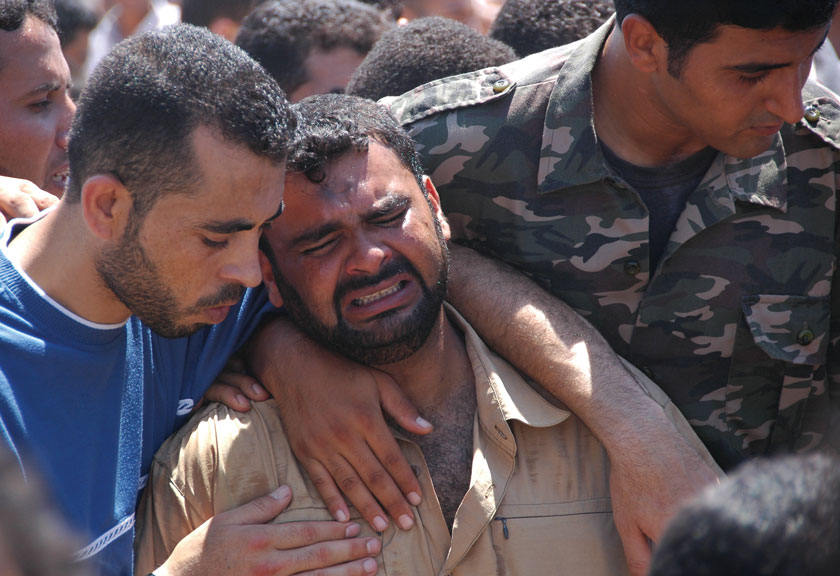Gaza’s Rockets: Weapons of Terror or Liberation?
7 min read
THE ROCKETS and mortars that Hamas and other Gaza militant groups fire into Israel are almost universally condemned. Most U.S. politicians blame these projectiles for the Israel-Gaza conflicts, and the U.N. and EU have condemned them. In 2014, President Barack Obama legitimized Israel’s “Protective Edge” assault on Gaza, stating, “As I’ve said repeatedly, Israel has a right to defend itself from rocket attacks that terrorize the Israeli people.” In November 2019, presidential candidate Joe Biden followed suit: ”Israel has a right to defend itself against terrorist threats. It is intolerable that Israeli citizens live their lives under the constant fear of rocket attacks.”
Rockets are a significant reason for Gaza’s continuing split with the West Bank: Palestinian Authority President Mahmoud Abbas has denounced them as “counterproductive,” accomplishing little and provoking Israeli retaliation endangering Gaza civilians.
ROCKETS, LAW, AND LIBERTY
For the international community, these denunciations reflect the rockets’ perceived violation of international humanitarian law (IHL), the area of international law concerned with the means of war. Attacks intentionally targeting civilians are absolutely prohibited under the principle of noncombatant immunity (NCI). Attacks that target military assets but incidentally impact civilians are acceptable only if their civilian impacts are proportionate to their military purposes. Attacks that can’t discriminate between military targets and civilians pose unacceptable risks to civilians and are forbidden because they’re indiscriminate. Gaza’s rockets lack internal guidance systems and thus are very inaccurate. So it’s generally infeasible to make meaningful distinction with them between military targets and civilians. Ergo, they’re indiscriminate and forbidden under IHL. Ditto for Gaza’s mortars.
Thus, compliance with IHL would require Gaza to end all use of its projectiles. But how can weak, technologically unsophisticated Gaza liberate itself from powerful, technologically advanced Israeli oppression if it’s deprived of its only possibility of impacting Israel militarily? Non-violent resistance alone won’t do—Palestinians have engaged in it for decades with little success, the most recent instance being Gaza’s “Great March of Return” that left 13,000 protesters severely wounded and over 180 dead at the hands of the Israeli military. The “peace process” has been an even greater failure.
IHL creates this conundrum by dissociating the justice of a party to the war’s cause from the means it can use in making war. Under this rubric, both aggressor and victim must comply with IHL in their means of combat. Gaza’s overwhelmingly just cause gives it no right whatsoever to utilize its projectiles against an entity that has dispossessed and oppressed it for over seven decades. Yet, foregoing them could condemn Gaza to perpetual oppression. As such, IHL is constituted to keep down the oppressed to the benefit of powerful oppressors. It also conflicts with relevant parts of international human rights law: the rights to liberty, freedom of movement and to return to one’s country.
ABSOLUTIST LAW IN EXTREME CIRCUMSTANCES
IHL’s “no exceptions” divorce of the justification for war from the means of war hasn’t gone uncontested. Michael Walzer proposes a striking exception in his classic Just and Unjust Wars. If a country is in a “Supreme Emergency”—imminent danger of conquest by an aggressor that would subject it to tyrannical oppression—then this preeminent justification for war gives it the right to fight by any means it chooses, including deliberately attacking the aggressor’s civilians. This rationale was implicit in Britain’s bombing of German civilians in WW II. Prime Minister Winston Churchill believed Britain’s only chance to avoid Nazi tyranny was to target German civilians. By doing so he hoped to undermine Germany’s military and/or to arouse its civilians to overthrow the Nazis. Though the impact on Germany’s war machine was minimal and no uprising occurred, these attacks, which killed more than 300,000 civilians, were tacitly accepted by the international community.
Although Walzer proposes only the Supreme Emergency exception to IHL’s separation of cause and means of war, there’s no a priori basis for disallowing additional exceptions. Gaza isn’t facing a Supreme Emergency—it’s enduring Supreme Oppression. The full scope of what was in store for it has manifested over decades rather than in one fell stroke.
Many Palestinian refugees fled to Gaza from their homes in what is now Israel to escape the 1948 war, expecting to return when the violence abated. Israel violated—and to this day violates—their right under international human rights law to return to their country. Thus, they have been largely confined to Gaza for decades, where they have languished in rampant unemployment and poverty. In 1967, Israel occupied Gaza, subjected it to harsh military rule and began colonizing it, shoving aside the refugees and brutally suppressing their resistance. Then it fenced in Gaza, making it into a big concentration camp. All of this contributed to Hamas’ rise to power and significant rocket attacks on Israel beginning in 2006, Israel’s strangling siege and blockade in 2007, intensified rocketing, and a series of savage Israeli reprisals from 2006 to 2014.
If Supreme Emergency warrants an exception to IHL, then such Supreme Oppression also warrants it. Britain struggled against a more powerful enemy to avoid tyranny and loss of liberty; Gaza is doing so to throw off tyranny and regain liberty. Its just cause for war is at least as strong as Britain’s was, and it has at least as much right as Britain did to choose its means of war. This doesn’t mean Gaza should fight “any way it chooses.” If it seeks liberty instead of revenge, it shouldn’t intentionally target Israeli civilians as have some of its militant factions. Such bald contravention of IHL is indeed counterproductive because of the condemnation it arouses by the governments and citizens of foreign nations, by the U.N., and by NGOs like Human Rights Watch and Amnesty International. U.N. and NGO reports of IHL violations in the conflict have far greater bearing on Gaza’s fortunes than any military impact its projectiles might have. These assessments have contributed to its ruling Hamas party and some of its militant factions being placed on lists of terrorist organizations, resulting in crippling economic sanctions—including the blockade—against Gaza.
IHL puts Gaza in a cruel catch-22 predicament. If it uses its projectiles in violation of IHL it can expect continued condemnation and the negative impacts it has on the Palestinian cause. If it forgoes them, it is likely to remain interminably under Israel’s knee. Humanitarian law that limits the oppressed to such intolerable options is itself inhumane and should be amended. For cases like Gaza’s, this amendment should permit regulated use of indiscriminate weapons involving reasonable relaxation of the noncombatant immunity of the oppressor’s civilians. This amendment would pertain to certain provisions of Additional Protocol I of the Fourth Geneva Convention and to other areas of IHL.
Per this amendment, “regulated use” of such indiscriminate weapons would be available only to entities enduring extreme, perpetual violation of their human rights under international law. Regulated use of such weapons must be essential to gaining those rights, and there must be no viable alternative for gaining those rights. They must not be used for extraneous purposes such as terrorism or vengeance. They must have only military objectives, although there can be no guarantee that they will not impact oppressors’ civilians or that those impacts will be proportionate to their military objectives. Oppressors bear responsibility for impacts upon their civilians because they force oppressed entities to utilize such weapons by depriving people of their lawful human rights. This responsibility would be reinforced in cases like Gaza’s in which—as documented by Amnesty International—the oppressor locates its military assets in or near its civilian areas, from which it launches attacks against the oppressed entity.
The amendment should also provide for termination of the use of such weapons as soon as an oppressor terminates its violations of an oppressed entity’s human rights. In Gaza’s case, Israel would have to end its blockade and sanctions against Gaza and permit its refugees to return to their country or—if they prefer—make restitution to them based upon expert, disinterested assessment of their losses.
WEAPONS OF LIBERATION
Whether or not IHL is so amended, Gaza has a moral right to such regulated use of its projectiles to cast off Zionist tyranny. It is suggested that its leadership clarify to the international community its right to use its projectiles based on principles such as those in the proposed amendment. Israel probably would still retaliate disproportionately, but international sentiment might then shift toward Gaza. These changes in Gaza’s means of war undoubtedly require new or reformed leadership that can unite its populace and factions in purpose and policy. Challenging though all this is, it may be Gaza’s only viable path to liberty. Such changes also could open the way for reunification with the West Bank establishment in averting the extinction of Palestinian statehood hopes, now critically endangered by Israel’s annexation agenda





